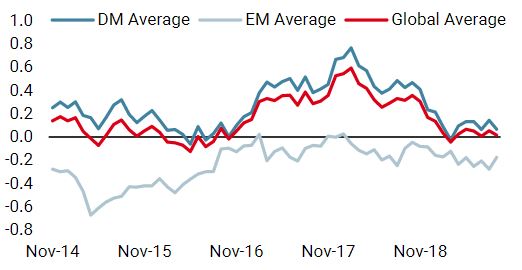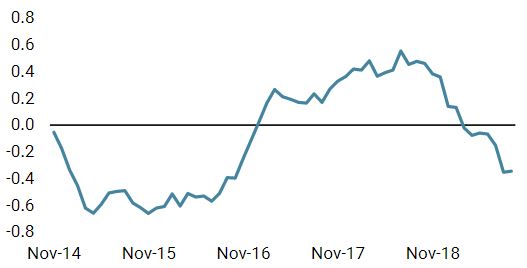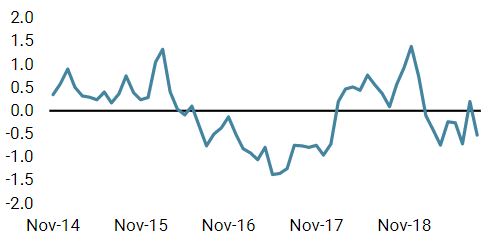The last few weeks have seen central banks continue to ease their policy stances in response to tepid global growth and the absence of inflationary pressures. The ECB cut its deposit rate by 0.10% and relaunched their asset purchase programme for “as long as necessary,” while the Fed cut its target rate by 0.25% and indicated that another cut could follow by the end of the year if necessary. The actions were largely in line with investor expectations and the market reaction was relatively muted. With these two key events in the rear-view mirror, can we dream of a long, straight road ahead? Or will investors catch a fever, burning up inside? We have communicated for some time our concerns about the Eurozone, with both peripheral countries such as Italy and core countries like Germany approaching recessionary levels. With inflation pressures low, the ECB needed to deliver an aggressive stimulus package in order to kick-start the economy. In some key ways, it did deliver: in addition to the 10bps cut to the deposit rate and a resumption of quantitative easing, its extension of LTRO maturities and the introduction of a two-tier system for reserves should ensure that credit conditions in Europe remain easy. The ECB’s forward guidance to help the economy “as long as necessary” is a strong commitment from the central bank that monetary policy will remain supportive for some time. This will be important as credit showed signs of tightening broadly according to the Q2 2019 ECB Bank Lending survey (BLS), primarily driven by concerns around the economic outlook and banks’ increased risk aversion. At the same time, the BLS survey pointed to increased demand for credit, from both businesses and households (home purchases as well as consumer credit). The pickup in credit demand was mainly due to the low level of interest rates and spending (on fixed investment for businesses and on durable goods for consumers). This improved credit demand picture needs to be sustained if the ECB wants to avoid ‘pushing on a string’ with its monetary policies.“I Drove All Night” – Roy Orbison, 1992
What’s Next?
Macro: Central Bank Support Continues
The Fed faces a different set of challenges: the US economy continues to grow at a decent rate, though at a slower pace than it did in early 2019. However, the uncertainty introduced by trade tensions and the broader global growth slowdown have skewed the risks to the downside. Continuing its policy stance of a mid-cycle adjustment, the Fed cut their target rate by 25bps and their median projection calls for one more cut this year, though that will surely depend on how the economy evolves over the next few months.
Importantly, the inflation forecasts were unchanged while growth was revised higher for 2019 (2.2% from 2.1%) and 2021 (1.9% from 1.8%). Clearly, the Fed acknowledges that growth momentum persists, leading to wide dispersion on the need for further cuts according to the so-called “dot plot.” At this point, the Fed would likely need to see a significant worsening of the US economy to cut rates further. Indeed, both for the Fed and the ECB, there is less consensus among their members, which effectively raises the bar for further easing going forward.
Sentiment: Investors Seem to Continue Their Defensive Stance
Despite a decent macro picture – global growth remains around potential, inflation is nowhere to be seen, and central banks are providing support – investors still appear to be maintaining a fairly cautious view on risky assets. Although no one indicator would be enough on its own, the confluence of multiple perspectives on a cross-asset basis points to the market’s defensive stance:
- Government bonds remain the most expensive risk premia based on their historical and cross-sectional carry, despite very low or even negative yields;
- Safe-haven currencies, like the Japanese yen and Swiss franc, remain overvalued;
- Positioning in gold, whether in ETFs or futures contracts, remains elevated on a historical basis and has not been meaningfully reduced despite the run up in the gold price;
- The implied equity beta of macro hedge funds and CTAs has moved from strongly positive two months ago to now negative, suggesting these investors have moved net short equities; and
- The short-term downside skew for equity options remains elevated, with the S&P 500 index seeing levels at around the 80th percentile historically and the Euro Stoxx 50 index at the 90th percentile.
In our view, such defensive positioning would be reasonable today if recession risk was high or there was a significant escalation in the trade war. The former seems unlikely, at least at the global level. And while the latter is a risk that will likely be with us for some time, recent developments have been neutral. This motivates our view that the risks from sentiment are tilted to the upside for growth assets, as investor defensiveness seems overdone. Indeed, we communicated in early September that hedging assets, such as bonds, looked overbought on the back of considerable optimism about central bank easing. The first half of this month has seen that optimism wane. We believe the pain trade remains to the upside for growth assets.
Valuation: Few Opportunities But Clear Risks
Based on carry, most assets are expensive from a historical perspective. However, corporate credit (both investment grade and high yield) stands out as inexpensive from a cross-sectional basis, partly motivating our overweight in credit. And despite rising yields on government bonds, they still remain expensive and a clear valuation risk. Interestingly, equities are roughly neutral, both from a cross-asset carry perspective and traditional equity-specific valuation metrics such as price-to-earnings or price-to-book, especially in emerging markets. Thus, valuations are reinforcing our pro-growth assessment.

Asset Allocation: Risk-on, But Looking to Remain Vigilant
For now, hedging assets seem the most vulnerable to the combination of resilience in economic growth, extreme positioning and tense valuations. We have therefore reduced substantially our exposure to these assets and reallocated to growth-oriented ones, especially credit. Gaining downside protection via options is costly given investor defensiveness and we are instead looking for cost-efficient structures with attractive payoff profiles.

I Drove All Night

Our medium-term view is currently more constructive, as we are still overweight growth assets and underweight real assets. We are also complementing our exposures with options to protect the portfolio in the case of equity drawdowns. Over September to date, the Multi Asset Risk Targeted Strategy is up 1.0% versus 3.0% for the MSCI AC World Index, while the Barclays Global Aggregate (USD hedged) is down 0.9%. Year-to-date, the Multi Asset Risk Targeted Strategy has returned 10.3% versus 17.2% for the MSCI AC World index and 8.3% for the Barclays Global Aggregate (USD hedged) index. * The Multi Asset Risk Targeted Strategy performance is shown in USD net of fees for the representative account of the Multi Asset Risk Targeted (Medium) USD Composite and reflects the deduction of advisory fees and brokerage commission and the reinvestment of all dividends and earnings. Past performance is not indicative of future performance. This information is presented as supplemental information only and complements the GIPS compliant presentation provided on the following page.Strategy Behaviour
Performance Review
Unigestion Nowcasting
World Growth Nowcaster

World Inflation Nowcaster

Market Stress Nowcaster

Weekly Change
- Our world Growth Nowcaster remains unchanged, pointing to world growth around potential.
- Our world Inflation Nowcaster continued to stabilise last week, after a long period of decline.
- Market stress increased marginally last week as credit spreads widened slightly.
Sources: Unigestion. Bloomberg, as of 23 September 2019.
Important Information
Past performance is no guide to the future, the value of investments can fall as well as rise, there is no guarantee that your initial investment will be returned. This document has been prepared for your information only and must not be distributed, published, reproduced or disclosed by recipients to any other person. This is a promotional statement of our investment philosophy and services only in relation to the subject matter of this presentation. It constitutes neither investment advice nor recommendation. This document represents no offer, solicitation or suggestion of suitability to subscribe in the investment vehicles it refers to. Please contact your professional adviser/consultant before making an investment decision. Where possible we aim to disclose the material risks pertinent to this document, and as such these should be noted on the individual document pages. Please contact Unigestion for a complete list of all the applicable risks. Some of the investment strategies described or alluded to herein may be construed as high risk and not readily realisable investments, which may experience substantial and sudden losses including total loss of investment. These are not suitable for all types of investors. To the extent that this report contains statements about the future, such statements are forward-looking and subject to a number of risks and uncertainties, including, but not limited to, the impact of competitive products, market acceptance risks and other risks. As such, forward looking statements should not be relied upon for future returns. Data and graphical information herein are for information only and may have been derived from third party sources. Unigestion takes reasonable steps to verify, but does not guarantee, the accuracy and completeness of this information. As a result, no representation or warranty, expressed or implied, is or will be made by Unigestion in this respect and no responsibility or liability is or will be accepted. All information provided here is subject to change without notice. It should only be considered current as of the date of publication without regard to the date on which you may access the information. Rates of exchange may cause the value of investments to go up or down. An investment with Unigestion, like all investments, contains risks, including total loss for the investor.
This information is issued by Unigestion (UK) Ltd (“Unigestion”), which is authorised and regulated by the UK Financial Conduct Authority (“FCA”). Unigestion is also registered as an investment adviser with the U.S. Securities and Exchange Commission (“SEC”). This information is intended only for professional clients, institutional clients and eligible counterparties, as defined by the FCA, and qualified purchasers as defined by the SEC and has therefore not been adapted to retail clients.
Unigestion Multi Asset Risk-Targeted (USD): 31 December 2014 to 30 June 2019
| Year | Composite Return Gross of Fees |
Composite Net Return | Benchmark Return | Number of Accounts | Internal Dispersion | Composite 3-Yr Std Dev | Benchmark 3-Yr Std Dev | Composite AUM (M) | Firm AUM (M) |
| 2015 | -1.61% | -2.80% | – | 1 | – | – | – | 127.24 | 15,550.31 |
| 2016 | 5.05% | 3.79% | – | 1 | – | – | – | 129.66 | 18,144.46 |
| 2017 | 11.16% | 9.82% | – | 1 | – | – | – | 169.51 | 22,340.80 |
| 2018 | -2.91% | -4.08% | – | 1 | – | – | – | 286.93 | 21,403.49 |
| 20191 | 7.45% | 6.80% | – | 1 | – | – | – | 364.46 | 21,692.55 |
1: This year is incomplete, it stops in June.
Special Disclosure: For presentations prior to 31.03.2018 the strategy was measured against the LIBOR 3M USD + 4%. Beginning April 2018 the firm determined that the benchmark did not accurately reflect the strategy mandate and the benchmark was removed. Definition of the Firm: For the purposes of applying the GIPS Standards, the firm is defined as Unigestion. Unigestion is responsible for managing assets on the behalf of institutional investors. Unigestion invests in several strategies for institutional clients: Equities, Hedge Funds, Private Assets and the solutions designed for the clients of our Cross Asset Solution department. The GIPS firm definition excludes the Fixed Income Strategy Funds, which started in January 2001 and closed in April 2008, and the accounts managed for private clients. Unigestion defines the private clients as High Net Worth Families and Individual investors. Policies: Unigestion policies for valuing portfolios, calculating performance, and preparing compliant presentations are available upon request. Composite Description: The Multi Risk Targeted (Medium) composite was defined on 15 December 2014. It consists of accounts which aim to deliver consistent smooth returns of cash + 5% gross of fees across all market conditions over a 3-year rolling period. It seeks to achieve this by capturing the upside during bull markets while protecting capital during market downturns. Benchmark: Because the composites strategy is absolute return and investments are permitted in all asset classes, no benchmark can reflect this strategy accurately. Fees: Returns are presented gross of management fees, administrative fees but net of all trading costs and withholding taxes. The maximum management fee schedule is 1.2% per annum. Net returns are net of model fees and are derived by deducting the highest applicable fee rate in effect for the respective time period from the gross returns each month. List of Composites: A list of all composite descriptions is available upon request. Minimum Account Size: The minimum account size for this composite is 5’000’000.- USD. Valuation: Valuations are computed in US dollars (USD). Performance results are reported in US dollars (USD). Internal Dispersion & 3YR Standard Deviation: The annual composite dispersion presented is an asset-weighted standard deviation calculated for the accounts in the composite the entire year. When internal dispersion is not presented it is as a result of an insufficient number of portfolios in the composite for the entire year. When the 3 Year Standard Deviation is not presented it is as a result of an insufficient period of time. Compliance Statement Unigestion claims compliance with the Global Investment Performance Standards(GIPS®) and has prepared and presented this report in compliance with the GIPS standards. Unigestion has been independently verified for the periods 1 January 2003 to 31 December 2016. The verification report(s) is/are available upon request. Verification assesses whether (1) the firm has complied with all the composite construction requirements of the GIPS standards on a firm-wide basis and(2) the firms policies and procedures are designed to calculate and present performance in compliance with the GIPS standards. Verification does not ensure the accuracy of any specific composite presentation.
